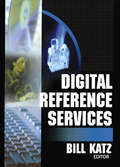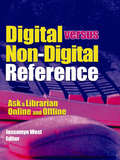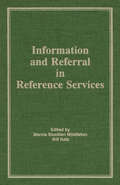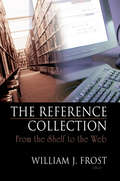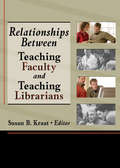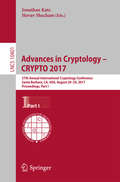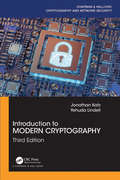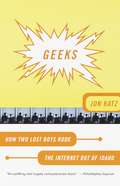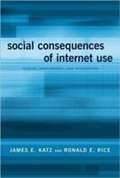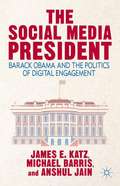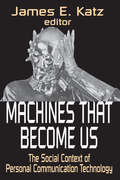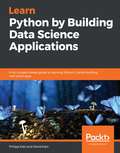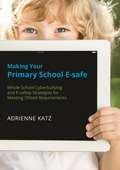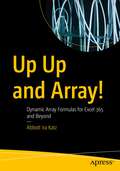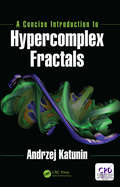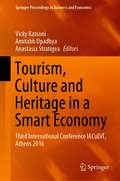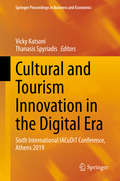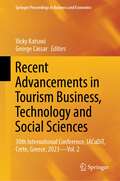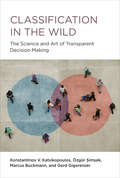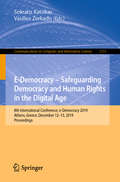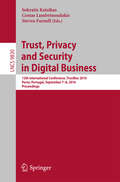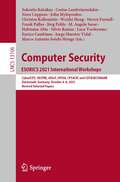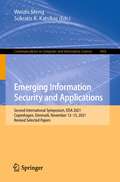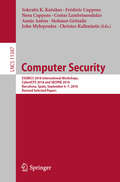- Table View
- List View
Digital Reference Services
by Linda S KatzExtensive data on the theoretical and practical aspects of electronic reference services! Digital Reference Services provides an overview of electronic reference services and software, and explores the opportunities that real-time digital reference services can offer in a variety of library settings. Experts in the field convey numerous opinions and theory about the growth of this new approach to answering reference questions. This book teaches librarians new methods and techniques for offering technologically advanced reference services to the public. The first half of Digital Reference Services includes such topics as: real-time or "live online" reference services the historical development of digital reference services and the role of the reference librarian mediated online searches how to create a virtual-ready reference collection of elite reference Web sites-includes a list of the top sites available to the public how to start and operate a digital reference desk in your library The second half of Digital Reference Services covers examples of libraries-both large and small-which have used revolutionary ideas to bring electronic reference services to their patrons. These ideas include: utilizing ATM-like kiosks in remote locations from library buildings to connect with underserved populations implementing live, interactive web-based reference services-the challenges and benefits, cost, training, and workload requirements evaluating your real-time references services-investigating self-assessment and blind reviewing, incorporating your assessment into an existing evaluative program, and obtaining the administrative support essential for an accurate assessment creating a statewide virtual reference system-selecting software, developing policy, marketing, coordinating the project, and staffing and training online reference management for smaller libraries-because of the smaller staff, smaller budget, and smaller amount of patrons, is it a feasible addition to the library? much more! This well-referenced volume contains case examples, figures, useful Web sites, and case histories to show how the basic principles of digital reference services work. Librarians and students of information and library science will find Digital Reference Services a helpful resource to enhance their library and electronic reference expertise.
Digital versus Non-Digital Reference: Ask a Librarian Online and Offline
by Linda S KatzCompare and contrast library reference models and more consumer-oriented models! Digital versus Non-Digital Reference: Ask A Librarian Online and Offline analyzes the quality of commercial Ask A Librarian (AskA) and tutorial services and how they compare to traditional library services. Edited by Jessamyn West-proprietor of librarian.net and the "hippest ex-librarian on the Web" according to Wired magazine-the book looks at library models and more consumer-oriented models, examining a variety of services that range from Ask Jeeves® and Google Answers to your own reference desk and Web e-mail reference forms. Academic librarians and information specialists share their experiences-good and bad-in starting, assessing, or ending AskA services and in working with collaborative reference tools and outsourcing reference services, and discuss the highs and lows of dealing with individual online services. Digital versus Non-Digital Reference: Ask A Librarian Online and Offline chronicles the experiences and interactions of librarians with digital reference, including case studies, how-to guides, and philosophical essays. The book&’s contributors discuss their concerns about using the Internet as not only a reference tool but as a reference medium that most libraries find inevitable to some degree. Topics include the political ramifications of offsite or outsourced reference, the truth behind the assertion that "it&’s all available online," cultural and/or language barriers to text-based reference services, and patrons&’ experiences with reference tools, from a librarian&’s perspective. Digital versus Non-Digital Reference: Ask A Librarian Online and Offline addresses: policy, staffing and technology for telephone reference services e-mail reference in public libraries the University of Michigan&’s Internet Public Library archivists and remote users in the digital age success and failure with commercial AskA programs the history of Q and A NJ, New Jersey&’s virtual reference service multilingual chat reference systems the ongoing debate over the value of digital reference the case for nonintrusive reference Digital versus Non-Digital Reference: Ask A Librarian Online and Offline is an invaluable resource for practitioners and academics on the appropriate assessment, technologies, and methods for successfully creating and operating human-mediated, Internet-based information services.
Information and Referral in Reference Services
by Linda S KatzThis book investigates a wide variety of situations and models which fall under the umbrella of information and referral. It examines traditional views in public libraries and library systems as well as descriptions of programs in nontraditional settings, such as academic libraries. A human services perspective is explored and research models are presented.
The Reference Collection: From the Shelf to the Web
by Linda S KatzStay up-to-date with the growing amount of reference resources available onlineHow important is the World Wide Web to information retrieval and communication? Important enough that information professionals have seen students exit from their libraries en masse when Internet service was lost. Internet providers dominate the indexing and abstracting of periodical articles as major publishers now offer nearly all of their reference titles in digital form. Libraries spend increasing amounts of funding on electronic reference materials, and librarians devote an increasing amount of time to assisting in their use. The Reference Collection: From the Shelf to the Web is an essential guide to collection development for electronic materials in academic and public libraries. The Reference Collection: From the Shelf to the Web tracks the continuing evolution of electronic reference resources-and how they&’re accessed-in a variety of settings. Librarians representing university, elementary school, and public libraries in the United States and Australia examine how reference collections have evolved over time (and may soon be a thing of the past); how public and school libraries have dealt with the changes; why library research assignments have become more difficult for teachers to make and for students to complete; how to organize online reference sources; and why the nature of plagiarism has changed in the electronic era. The book also examines the use of electronic references from a publisher&’s perspective and looks at the most important Web-accessible reference tools-both free and subscription-in the areas of humanities, medicine, the social sciences, business, and education. The Reference Collection: From the Shelf to the Web also examines: issues of authority, accessibility, cost, comfort, and user education in evaluating electronic resources the formation of purchasing consortia to facilitate the transfer of reference materials from print to online formats current literature and research findings on the state of digital versus print reference collections what electronic publishing means to smaller reference books (dictionaries, almanacs, etc.) the need for increased information literacy among students the nature, extent, and causes of cyber plagiarism the use of federated search tools and includes a selected list of the top 100 free Internet reference sitesThe Reference Collection: From the Shelf to the Web is an essential resource for all reference and collection development librarians, and an invaluable aid for publishing professionals.
Relationships Between Teaching Faculty and Teaching Librarians
by Linda S KatzEvery librarian who teaches in an academic library setting understands the complexities involved in partnering with teaching faculty. Relationships Between Teaching Faculty and Teaching Librarians recounts the efforts of librarians and faculty working together in disciplines across the board to create and sustain connections crucial to the success of library instruction. This unique collection of essays examines various types of partnerships between librarians and faculty (networking, coordination, and collaboration) and addresses the big issues involved, including teaching within an academic discipline, the intricacies of assigning grades, faculty perceptions of library instruction, and the changing role of the reference librarian. Education is the main focus of reference service in today's academic libraries and librarians teach a variety of single-session, course-related, course-integrated, or credit-bearing courses in nearly every discipline. Relationships Between Teaching Faculty and Teaching Librarians reflects the experiences of librarians, teaching faculty, and library directors, whose perspectives range from cynicism to cautious optimism to idealism when it comes to working with teaching faculty. The book includes case studies, surveys, sample questionnaires, statistics, and a toolkit for establishing an effective library liaison program, and examines the teaching and learning environment, course growth and maintenance, and the "professor librarian" model. Relationships Between Teaching Faculty and Teaching Librarians presents lessons learned from seeking a common ground including: a successful faculty/librarian collaboration for educational psychology and counseling a library research project for freshman engineering students a semester-by-semester look at a collaboratively taught graduate research and writing course a survey that determines how librarians and library directors feel about teaching outside the library an analysis of librarians&’ attitudes toward faculty an analysis of attitudes that influence faculty collaboration in library instruction a look at innovative methods of increasing the teaching roles of librarians and much more! The Middle States Commission on Higher Education (MSA/CHE) has mandated that information literacy be included as part of a general education requirement. If your faculty wasn't calling for library instruction before the mandate, it probably is now. Relationships Between Teaching Faculty and Teaching Librarians will help librarians establish communication with faculty that provides a solid foundation for coursework in all disciplines.
Advances in Cryptology – CRYPTO 2017: 37th Annual International Cryptology Conference, Santa Barbara, CA, USA, August 20–24, 2017, Proceedings, Part I (Lecture Notes in Computer Science #10401)
by Jonathan Katz Hovav ShachamThe three volume-set, LNCS 10401, LNCS 10402, and LNCS 10403, constitutes the refereed proceedings of the 37th Annual International Cryptology Conference, CRYPTO 2017, held in Santa Barbara, CA, USA, in August 2017. The 72 revised full papers presented were carefully reviewed and selected from 311 submissions. The papers are organized in the following topical sections: functional encryption; foundations; two-party computation; bitcoin; multiparty computation; award papers; obfuscation; conditional disclosure of secrets; OT and ORAM; quantum; hash functions; lattices; signatures; block ciphers; authenticated encryption; public-key encryption, stream ciphers, lattice crypto; leakage and subversion; symmetric-key crypto, and real-world crypto.
Introduction to Modern Cryptography (Chapman & Hall/CRC Cryptography and Network Security Series)
by Jonathan Katz Yehuda LindellNow the most used texbook for introductory cryptography courses in both mathematics and computer science, the Third Edition builds upon previous editions by offering several new sections, topics, and exercises. The authors present the core principles of modern cryptography, with emphasis on formal definitions, rigorous proofs of security.
Geeks: How Two Lost Boys Rode the Internet out of Idaho
by Jon KatzJ<P>esse and Eric were roommates in the tiny town of Caldwell, Idaho, nineteen-year-old working class kids eking out a living with their seven-dollar-an-hour jobs selling and fixing computers. College was never in the cards. Their families had been torn apart by divorce and hard times, separation and illness. They had almost no social lives, and little to look forward to. They spent every spare cent on their computers, and every spare moment on-line. <P>Jesse and Eric were proud geeks-- suspicious or disdainful of authority figures, proud of their status as outsiders, fervent in their belief in the positive power of technology. They'd been outsiders as long as they could remember, living far from the mainstream of school or town life. Nobody spoke for them, they were on nobody's social or political agenda. <P>Geeks is the story of how Jesse and Eric--and others like them--used technology to try and change their lives and alter their destiny. They rode the Internet out of Idaho to Chicago, a city they had ever set foot in, seeking the American Dream, a better life. Geeks describes this brave and difficult journey, as two self-described social misfits use the resources of the Internet to try to construct a new future for themselves, escape the boundaries of their dead-end lives, and find a community they could belong to. <P>Geeks explores a growing subculture about which many of us know little, a world with its own language, traditions, and taboos. In telling the stories of Jesse, Eric, and others like them, Geeks is a story about the very human face of technology. <P>[This text is listed as an example that meets Common Core Standards in English language arts in grades 6-8 at http://www.corestandards.org.]
Social Consequences of Internet Use: Access, Involvement, and Interaction
by James E. Katz Ronald E. RiceAuthors explore the impact of the Internet on society from three perspectives: access to Internet technology, involvement with groups and communities through the Internet, and use of the Internet for social interaction and expression.
The Social Media President
by James E. Katz Michael Barris Anshul JainThe proliferation of social media has altered the way that people interact with each other - leveling the channels of communication to allow an individual to be "friends" with a sitting president. In a world where a citizen can message Barack Obama directly, this book addresses the new channels of communication in politics, and what they offer.
Machines That Become Us: The Social Context of Personal Communication Technology
by James E. KatzSocial critics and artificial intelligence experts have long prophesized that computers and robots would soon relegate humans to the dustbin of history. Many among the general population seem to have shared this fear of a dehumanized future. But how are people in the twenty-first century actually reacting to the ever-expanding array of gadgets and networks at their disposal? Is computer anxiety a significant problem, paralyzing and terrorizing millions, or are ever-proliferating numbers of gadgets being enthusiastically embraced? Machines that Become Us explores the increasingly intimate relationship between people and their personal communication technologies.In the first book of its kind, internationally recognized scholars from the United States and Europe explore this topic. Among the technologies analyzed include the Internet, personal digital assistants (PDAs), mobile phones, networked homes, smart fabrics and wearable computers, interactive location badges, and implanted monitoring devices. The authors discuss critical policy issues, such as the problems of information resource access and equity, and the recently discovered digital dropouts phenomena.The use of the word become in the book's title has three different meanings. The first suggests how people use these technologies to broaden their abilities to communicate and to represent themselves to others. Thus the technologies become extensions and representatives of the communicators. A second sense of become applies to analysis of the way these technologies become physically integrated with the user's clothing and even their bodies. Finally, contributors examine fashion aspects and uses of these technologies, that is, how they are used in ways becoming to the wearer. The conclusions of many chapters are supported by data, including ethnographic observations, attitude surveys and case studies from the United States, Britain, France, Italy, Finland, and Norway. This approach is especially valuable
Learn Python by Building Data Science Applications: A fun, project-based guide to learning Python 3 while building real-world apps
by David Katz Philipp KatsUnderstand the constructs of the Python programming language and use them to build data science projects Key Features Learn the basics of developing applications with Python and deploy your first data application Take your first steps in Python programming by understanding and using data structures, variables, and loops Delve into Jupyter, NumPy, Pandas, SciPy, and sklearn to explore the data science ecosystem in Python Book Description Python is the most widely used programming language for building data science applications. Complete with step-by-step instructions, this book contains easy-to-follow tutorials to help you learn Python and develop real-world data science projects. The “secret sauce” of the book is its curated list of topics and solutions, put together using a range of real-world projects, covering initial data collection, data analysis, and production. This Python book starts by taking you through the basics of programming, right from variables and data types to classes and functions. You'll learn how to write idiomatic code and test and debug it, and discover how you can create packages or use the range of built-in ones. You'll also be introduced to the extensive ecosystem of Python data science packages, including NumPy, Pandas, scikit-learn, Altair, and Datashader. Furthermore, you'll be able to perform data analysis, train models, and interpret and communicate the results. Finally, you'll get to grips with structuring and scheduling scripts using Luigi and sharing your machine learning models with the world as a microservice. By the end of the book, you'll have learned not only how to implement Python in data science projects, but also how to maintain and design them to meet high programming standards. What you will learn Code in Python using Jupyter and VS Code Explore the basics of coding – loops, variables, functions, and classes Deploy continuous integration with Git, Bash, and DVC Get to grips with Pandas, NumPy, and scikit-learn Perform data visualization with Matplotlib, Altair, and Datashader Create a package out of your code using poetry and test it with PyTest Make your machine learning model accessible to anyone with the web API Who this book is for If you want to learn Python or data science in a fun and engaging way, this book is for you. You'll also find this book useful if you're a high school student, researcher, analyst, or anyone with little or no coding experience with an interest in the subject and courage to learn, fail, and learn from failing. A basic understanding of how computers work will be useful.
Making Your Primary School E-safe: Whole School Cyberbullying and E-safety Strategies for Meeting Ofsted Requirements
by Adrienne KatzChildren are using the internet and mobile devices at increasingly younger ages, and it's becoming more and more important to address e-safety in primary schools. This practical book provides guidance on how to teach and promote e-safety and tackle cyberbullying with real-life examples from schools of what works and what schools need to do. The book explains how to set policy and procedures, how to train staff and involve parents, and provides practical strategies and ready-to-use activities for teaching e-safety and meeting Ofsted requirements. Including up-to-the-minute information and advice that includes new technologies, social media sites, and recent school policy trends such as 'Bring Your Own Device', this book provides all of the information that educational professionals need to implement successful whole school e-safety strategies.
Up Up and Array!: Dynamic Array Formulas for Excel 365 and Beyond
by Abbott Ira KatzUnderstand the power of dynamic arrays: a single formula can generate new and vastly more efficient spreadsheet possibilities. This book introduces spreadsheet users to dynamic array functions in Microsoft Excel 365, defines and details the distinctive ways in which they work, and shows how they can be applied to a wide swath of data-analytic tasks.While array formulas and functions have long held a place in the spreadsheet toolbox (although, for many of us, shunted to an obscure corner), the dynamic array engine offers a more user-friendly and intelligible set of means for manipulating spreadsheet data in the array mode. The single-formula, multi-cell capability of dynamic arrays has been extended to nearly all existing spreadsheet functions, offering a new, default way of working. As a result, many tasks can now be executed with dynamic arrays without having to resort to the new functions at all.After defining arrays and dynamic array formulas, this book helps you examine the dynamic array property of lifting and how it impacts the formulas, including those written with existing functions. Plenty of illustrations and formulas along the way help you get comfortable using them. From there, you will learn Excel 365’s new dynamic functions, including the 14 currently in rollout, each accompanied by instructive examples. In many cases, the examples demonstrate how the new functions can work with long-available functions, such as MID, IF, COUNTIF, etc., which now also boast dynamic array functionality. What You Will LearnUnlock the dynamic array potential in Microsoft ExcelApply dynamic array functions and confidently direct them to real-world spreadsheet tasksKnow the distinctive ways in which arrays work and can be applied to numerous data-analytic tasksWho This Book Is ForUsers of Excel 365 and beyond who are comfortable with, but not necessarily expert in, formula writing, as well as those who are unaware of or not fluent with dynamic arrays. It is also valuable to data journalists and other professionals in need of spreadsheet skills who may unaware of dynamic arrays, and the time they could save by applying them to their work.
A Concise Introduction to Hypercomplex Fractals
by Andrzej KatuninThis book presents concisely the full story on complex and hypercomplex fractals, starting from the very first steps in complex dynamics and resulting complex fractal sets, through the generalizations of Julia and Mandelbrot sets on a complex plane and the Holy Grail of the fractal geometry – a 3D Mandelbrot set, and ending with hypercomplex, multicomplex and multihypercomplex fractal sets which are still under consideration of scientists. I tried to write this book in a possibly simple way in order to make it understandable to most people whose math knowledge covers the fundamentals of complex numbers only. Moreover, the book is full of illustrations of generated fractals and stories concerned with great mathematicians, number spaces and related fractals. In the most cases only information required for proper understanding of a nature of a given vector space or a construction of a given fractal set is provided, nevertheless a more advanced reader may treat this book as a fundamental compendium on hypercomplex fractals with references to purely scientific issues like dynamics and stability of hypercomplex systems.
Discover SAP CRM (2nd Edition)
by Srini KattaDiscover what SAP CRM is and whether it's right for your business Learn from practical customer examples and real world insight New coverage of mobility, incident management, partner channel management, and more 2nd edition: Fully updated and expanded. It's a fact: companies that lose their customer undivided attention and sight of their customers' needs will lose those customers. SAP CRM provides you with the tools you need to attract and retain quality customers. Whether you're new to SAP or need to brush up on SAP CRM, this book will explain the core areas of CRM in an easy-to-understand manner. Perfect for managers and consultants, this book comprehensively explains what SAP CRM is, how it can improve your relationship with your customers, and how it can enhance cost effectiveness while improving profitability. Achieve customer-driven growth and explore the different ways SAP CRM can be integrated into your business. Supported by customer examples and practical insight, learn how SAP CRM works in the real world. Highlights- Marketing, sales, and service- Interaction centers- Web channels- Mobile applications- Partner channel management- Master data- Industry verticals.
Tourism, Culture and Heritage in a Smart Economy: Third International Conference IACuDiT, Athens 2016 (Springer Proceedings in Business and Economics)
by Vicky Katsoni Amitabh Upadhya Anastasia StratigeaThis book explores the ways in which information and communication technologies (ICTs) offer a powerful tool for the development of smart tourism. Numerous examples are presented from across the entire spectrum of cultural and heritage tourism, including art, innovations in museum interpretation and collections management, cross-cultural visions, gastronomy, film tourism, dark tourism, sports tourism, and wine tourism. Emphasis is placed on the importance of the smart destinations concept and a knowledge economy driven by innovation, creativity, and entrepreneurship. New modes of tourism management are described, and tourism products, services, and strategies for the stimulation of economic innovation and promotion of knowledge transfer are outlined. The potential of diverse emerging ICTs in this context is clearly explained, covering location-based services, internet of things, smart cities, mobile services, gamification, digital collections and the virtual visitor, social media, social networking, and augmented reality. The book is edited in collaboration with the International Association of Cultural and Digital Tourism (IACuDiT) and includes the proceedings of the Third International Conference on Cultural and Digital Tourism.
Cultural and Tourism Innovation in the Digital Era: Sixth International IACuDiT Conference, Athens 2019 (Springer Proceedings in Business and Economics)
by Vicky Katsoni Thanasis SpyriadisThis book explores a wide range of emerging cultural, heritage, and other tourism issues that will shape the future of hospitality and tourism research and practice in the digital and innovation era. It offers stimulating new perspectives in the fields of tourism, travel, hospitality, culture and heritage, leisure, and sports within the context of a knowledge society and smart economy. A central theme is the need to adopt a more holistic approach to tourism development that is aligned with principles of sustainability; at the same time, the book critically reassesses the common emphasis on innovation as a tool for growth-led and market-oriented development. In turn, fresh approaches to innovation practices underpinned by ethics and sustainability are encouraged, and opportunities for the exploration of new research avenues and projects on innovation in tourism are highlighted. Based on the proceedings of the Sixth International Conference of the International Association of Cultural and Digital Tourism (IACuDiT) and edited in collaboration with IACuDiT, the book will appeal to a broad readership encompassing academia, industry, government, and other organizations.
Recent Advancements in Tourism Business, Technology and Social Sciences: 10th International Conference, IACuDiT, Crete, Greece, 2023 - Vol. 2 (Springer Proceedings in Business and Economics)
by Vicky Katsoni George CassarThe book features the second volume of the proceedings of the 10th International Conference of the International Association of Cultural and Digital Tourism (IACuDiT), with the theme “Recent Advancements in Tourism Business, Technology, and Social Sciences,” which was held from August 29 to 31, 2023, in Crete, Greece. It showcases the latest research on Tourism Business, Technology, and Social Sciences and presents a critical academic discourse on smart and sustainable practices in the tourism industry, stimulating future debates and advancing readers’ knowledge and understanding of this critical area of tourism business in the post-COVID-19 era. COVID-19 produced dramatic effects on the global economy, business activities, and people, with tourism being particularly affected. The book discusses the resulting digital transformation process in a range of areas, including its effect on the social sciences combined with special forms of tourism. This accelerated digitalizationencourages the emergence of new digital products and services based on the principle of flexibility. The book focuses on the knowledge economy and smart destinations, as well as new modes of tourism management and development, and includes chapters on emerging technologies such as the Internet of Things, artificial intelligence, big data, and robotics in connection with various tourism practices.
Classification in the Wild: The Science and Art of Transparent Decision Making
by Konstantinos V. Katsikopoulos Ozgur Simsek Marcus Buckmann Gerd GigerenzerRules for building formal models that use fast-and-frugal heuristics, extending the psychological study of classification to the real world of uncertainty.This book focuses on classification--allocating objects into categories--"in the wild," in real-world situations and far from the certainty of the lab. In the wild, unlike in typical psychological experiments, the future is not knowable and uncertainty cannot be meaningfully reduced to probability. Connecting the science of heuristics with machine learning, the book shows how to create formal models using classification rules that are simple, fast, and transparent and that can be as accurate as mathematically sophisticated algorithms developed for machine learning.
E-Democracy – Safeguarding Democracy and Human Rights in the Digital Age: 8th International Conference, e-Democracy 2019, Athens, Greece, December 12-13, 2019, Proceedings (Communications in Computer and Information Science #1111)
by Sokratis Katsikas Vasilios ZorkadisThis book constitutes the refereed proceedings of the 8th International Conference on E-Democracy, E-Democracy 2019, held in Athens, Greece, in December 2019.The 15 revised full papers presented were carefully selected from 27 submissions. The papers are organized in topical sections on rrivacy and data protection; e-government; e-voting and forensics; online social networks and "fake news".
Trust, Privacy and Security in Digital Business
by Sokratis Katsikas Costas Lambrinoudakis Steven FurnellThis book presents the proceedings of the 6th International Conference on Trust, Privacy and Security in Digital Business (TrustBus 2009), held in Linz, Austria d- ing September 3-4, 2009. The conference continues from previous events held in Zaragoza (2004), Copenhagen (2005), Krakow (2006), Regensburg (2007) and Turin (2008). The advances in the information and communication technologies (ICT) have raised new opportunities for the implementation of novel applications and the pro- sion of high-quality services over global networks. The aim is to utilize this 'infor- tion society era' for improving the quality of life for all citizens, disseminating knowledge, strengthening social cohesion, generating earnings and finally ensuring that organizations and public bodies remain competitive in the global electronic m- ketplace. Unfortunately, such a rapid technological evolution cannot be problem free. Concerns are raised regarding the 'lack of trust' in electronic procedures and the - tent to which 'information security' and 'user privacy' can be ensured. TrustBus 2009 brought together academic researchers and industry developers, who discussed the state of the art in technology for establishing trust, privacy and security in digital business. We thank the attendees for coming to Linz to participate and debate the new emerging advances in this area.
Computer Security. ESORICS 2021 International Workshops: CyberICPS, SECPRE, ADIoT, SPOSE, CPS4CIP, and CDT&SECOMANE, Darmstadt, Germany, October 4–8, 2021, Revised Selected Papers (Lecture Notes in Computer Science #13106)
by Sokratis Katsikas Costas Lambrinoudakis Nora Cuppens John Mylopoulos Christos Kalloniatis Weizhi Meng Steven Furnell Frank Pallas Jörg Pohle M. Angela Sasse Habtamu Abie Silvio Ranise Luca Verderame Enrico Cambiaso Jorge Maestre Vidal Marco Antonio Sotelo MongeThis book constitutes the refereed proceedings of six International Workshops that were held in conjunction with the 26th European Symposium on Research in Computer Security, ESORICS 2021, which took place during October 4-6, 2021. The conference was initially planned to take place in Darmstadt, Germany, but changed to an online event due to the COVID-19 pandemic.The 32 papers included in these proceedings stem from the following workshops:the 7th Workshop on the Security of Industrial Control Systems and of Cyber-Physical Systems, CyberICPS 2021, which accepted 7 papers from 16 submissions;the 5th International Workshop on Security and Privacy Requirements Engineering, SECPRE 2021, which accepted 5 papers from 8 submissions;the 4th International Workshop on Attacks and Defenses for Internet-of-Things, ADIoT 2021, which accepted 6 full and 1 short paper out of 15 submissions; the 3rd Workshop on Security, Privacy, Organizations, and Systems Engineering, SPOSE 2021, which accepted 5 full and 1 short paper out of 13 submissions.the 2nd Cyber-Physical Security for Critical Infrastructures Protection, CPS4CIP 2021, which accepted 3 full and 1 short paper out of 6 submissions; and the 1st International Workshop on Cyber Defence Technologies and Secure Communications at the Network Edge, CDT & SECOMANE 2021, which accepted 3 papers out of 7 submissions.The following papers are available open access under a Creative Commons Attribution 4.0 International License via link.springer.com:Why IT Security Needs Therapy by Uta Menges, Jonas Hielscher, Annalina Buckmann, Annette Kluge, M. Angela Sasse, and Imogen VerretTransferring Update Behavior from Smartphones to Smart Consumer Devices by Matthias Fassl, Michaela Neumayr, Oliver Schedler, and Katharina Krombholz Organisational Contexts of Energy Cybersecurity by Tania Wallis, Greig Paul, and James Irvine SMILE - Smart eMaIl Link domain Extractor by Mattia Mossano, Benjamin Berens, Philip Heller, Christopher Beckmann, Lukas Aldag, Peter Mayer, and Melanie Volkamer A Semantic Model for Embracing Privacy as Contextual Integrity in the Internet of Things by Salatiel Ezennaya-Gomez, Claus Vielhauer, and Jana Dittmann Data Protection Impact Assessments in Practice - Experiences from Case Studies by Michael Friedewald, Ina Schiering, Nicholas Martin, and Dara Hallinan
Emerging Information Security and Applications: Second International Symposium, EISA 2021, Copenhagen, Denmark, November 12-13, 2021, Revised Selected Papers (Communications in Computer and Information Science #1403)
by Sokratis K. Katsikas Weizhi MengThis volume constitutes selected papers presented at the Second International Symposium on Emerging Information Security and Applications, EISA 2021, held in Copenhagen, Denmark, in November 2021.*The 10 full papers and 1 short paper presented in this volume were thoroughly reviewed and selected from the 36 submissions. They present a discussion on the emerging techniques, theories and applications to enhance information and application security in practice. *Due to the COVID-19 pandemic the conference was held online.
Computer Security: ESORICS 2018 International Workshops, CyberICPS 2018 and SECPRE 2018, Barcelona, Spain, September 6–7, 2018, Revised Selected Papers (Lecture Notes in Computer Science #11387)
by Sokratis K. Katsikas Frédéric Cuppens Nora Cuppens Costas Lambrinoudakis Annie Antón Stefanos Gritzalis John Mylopoulos Christos KalloniatisThis book constitutes the thoroughly refereed post-conference proceedings of the 4th International Workshop on the Security of Industrial Control Systems and Cyber-Physical Systems, CyberICPS 2018, and the Second International Workshop on Security and Privacy Requirements Engineering, SECPRE 2018, held in Barcelona, Spain, in September 2018, in conjunction with the 23rd European Symposium on Research in Computer Security, ESORICS 2018. The CyberICPS Workshop received 15 submissions from which 8 full papers were selected for presentation. They cover topics related to threats, vulnerabilities and risks that cyber-physical systems and industrial control systems face; cyber attacks that may be launched against such systems; and ways of detecting and responding to such attacks. From the SECPRE Workshop 5 full papers out of 11 submissions are included. The selected papers deal with aspects of security and privacy requirements assurance and evaluation; and security requirements elicitation and modelling.
